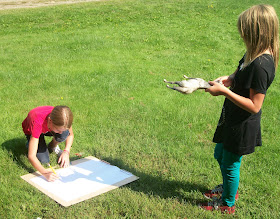THE ART MACHINE!
On my way to school I passed a yellow bike in a pile marked “FREE!”
I threw it in the car and brought it to school where I offered the bike to a small 5th grade class - “Anyone want to paint it?”
YES!
Before any paint would stick the bike needed a good washing-off - so buckets and sponges came out and 6 students started in on the task of cleaning off years of dirt.
CLICK to play
It was interesting to hear the ideas tumble out as the dirt was washed off:
“We could paint polka-dots on it.”
“We could paint the spokes rainbow-colors and watch them swirl when the wheels move.”
“How about neon colors?
“Nan could ride it all over town!
“We could put a wagon behind it and Nan could pull us!”
“We could put the 8th graders in the wagon!”
It was Friday morning - idea after idea practically exploded out of this group – like fireworks.
“I can't wait til Monday so we can paint it!”
End DAY 1
Over the weekend, I spray-painted the bike white and presented it to the group on Monday.
“It's like a blank canvas!”
Teacher:Who wants to work on it? How will you decide how to paint it?
Artists: Hands up if you want to paint the bike!
Teacher: Who will do what?
Artists: Let's make a list of ideas
Teacher: How many should paint at a time?
Artists: Two at a time seems like a good number
Teacher: Will you rotate after a certain number of minutes, or paint until you are done?
Artists: We should each paint until we are done and then switch
Teacher: Who goes first and how will you decide?
They decided – it was easy. And then the work began. Kids waiting for their turn mostly went on to their own work elsewhere in the class, checking in now and then to see how things were coming along.
It should have a name – like “The Art Machine.”
If we were driving it around town everyone would be so jealous!
They would crash into a tree if the saw it!
END DAY 2

















































